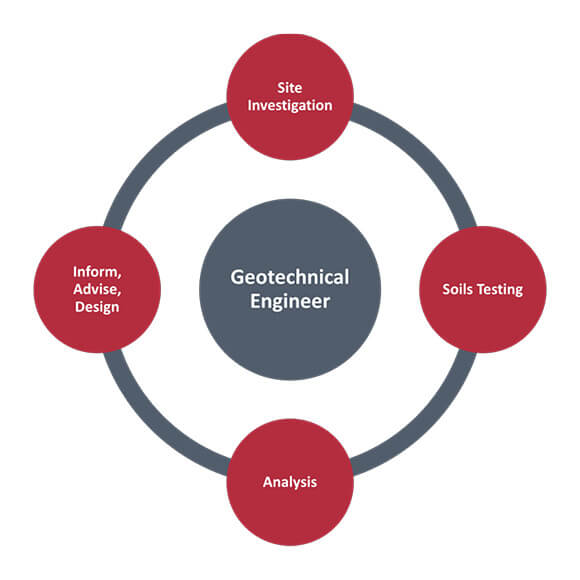The Facts About Geotheta Uncovered
The Facts About Geotheta Uncovered
Blog Article
The Best Guide To Geotheta
Table of ContentsSome Known Details About Geotheta What Does Geotheta Do?The Facts About Geotheta RevealedAll About GeothetaWhat Does Geotheta Do?

They conduct website examinations, gather examples, do research laboratory examinations, and assess information to assess the suitability of the ground for construction jobs - Consulting Engineers. Based on their findings, geotechnical engineers supply suggestions for structure design, slope security, preserving structures, and reduction of geotechnical hazards. They collaborate with various other specialists, such as designers, architectural designers, and building and construction groups, to ensure that geotechnical factors to consider are incorporated right into the general job design and execution
By analyzing the behavior and residential or commercial properties of dirt and rock, they can identify possible geotechnical dangers such as landslides, dirt settlement, or incline instability. Their knowledge helps prevent failures or accidents that might jeopardize lives and residential property. Below are some in-depth duties and responsibilities of a geotechnical designer: Website Examination: Geotechnical designers conduct website investigations to collect data on subsurface conditions.
They translate the data to understand the residential properties and habits of the dirt and rock, including their stamina, permeability, compaction qualities, and groundwater conditions. Geotechnical Analysis and Style: Geotechnical designers examine the data accumulated during site investigations to examine the stability and viability of the website for building and construction projects. They do geotechnical computations and modeling to examine variables such as bearing capability, negotiation, slope security, lateral earth stress, and groundwater circulation.
The Main Principles Of Geotheta
Foundation Style: Geotechnical engineers play an essential role in creating foundations that can safely sustain the designated structure. They assess the dirt conditions and load demands to figure out the ideal foundation kind, such as shallow foundations (e.g., footings), deep structures (e.g (https://ameblo.jp/geotheta/entry-12862281966.html)., piles), or specialized strategies like soil improvement. They think about aspects such as settlement limits, birthing capacity, and soil-structure interaction to establish optimal structure styles
They review construction strategies, display website activities, and carry out field assessments to verify that the design suggestions are adhered to. If unpredicted geotechnical concerns arise, they assess the circumstance and supply recommendations for remediation or modifications to the layout. Danger Analysis and Mitigation: Geotechnical designers examine geotechnical threats and risks related to the project website, such as landslides, liquefaction, or dirt erosion.

Cooperation and Interaction: Geotechnical engineers function very closely with various other experts entailed in a task, such as designers, architectural engineers, and construction teams. Efficient interaction and cooperation are crucial to integrate geotechnical factors to consider right into the total project design and building process. Geotechnical engineers give technical proficiency, solution inquiries, and guarantee that geotechnical requirements are met.
Geotheta - Questions
Here are some kinds of geotechnical engineers: Structure Designer: Foundation designers concentrate on making and assessing structures for frameworks. They analyze the soil conditions, tons demands, and site attributes to establish the most appropriate structure type and design, such as superficial foundations, deep foundations, or specialized strategies like heap foundations.
They review the factors affecting incline stability, such as soil residential properties, groundwater conditions, and slope geometry, and create techniques to avoid slope failures and minimize dangers. Quake Designer: Earthquake engineers concentrate on assessing and designing frameworks to stand up to seismic forces. They analyze the seismic threat of a website, examine soil liquefaction potential, and develop seismic design criteria to guarantee the safety basics and durability of frameworks throughout quakes.
They carry out area screening, gather examples, and assess the accumulated data to define the soil buildings, geologic formations, and groundwater problems at a website. Geotechnical Instrumentation Designer: Geotechnical instrumentation designers concentrate on surveillance and measuring the habits of soil, rock, and frameworks. They set up and maintain instrumentation systems that check elements such as dirt negotiation, groundwater degrees, slope activities, and structural variations to examine efficiency and offer early cautions of prospective issues.
Geotheta for Beginners
They conduct tests such as triaxial tests, loan consolidation tests, direct shear tests, and leaks in the structure tests to gather data for geotechnical analysis and design. Geosynthetics Engineer: Geosynthetics engineers concentrate on the design and application of geosynthetic products, such as geotextiles, geogrids, and geomembranes. They use these materials to boost dirt security, reinforce slopes, supply drain solutions, and control erosion.
They have a tendency to be investigative people, which means they're intellectual, reflective, and curious. They are curious, methodical, logical, analytical, and logical. Some of them are likewise social, indicating they're kind, generous, cooperative, patient, caring, valuable, compassionate, tactful, and friendly - Consulting Engineers.
In the workplace environment, geotechnical designers make use of specialized software application devices to carry out estimations, create styles, and analyze information. They prepare reports, review job specifications, interact with customers and team participants, and coordinate project tasks. The workplace setup offers a favorable environment for research study, analysis, and cooperation with various other professionals involved in the task.
7 Simple Techniques For Geotheta
They often check out job sites to conduct website investigations, examine geotechnical conditions, and collect information for analysis. These sees include taking a trip to different areas, sometimes in remote or challenging terrains. Geotechnical designers may carry out soil sampling, conduct tests, and display building tasks to guarantee that the geotechnical elements of the task are being executed appropriately.
Geotechnical engineers likewise operate in specialized geotechnical laboratories. In these centers, they conduct experiments, execute examinations on soil and rock samples, and evaluate the engineering residential or commercial properties of the products. Geotechnical laboratory designers work thoroughly in these environments, managing testing devices, operating instruments, and taping information. They work together with other research laboratory team to make sure precise and reliable testing results.
Report this page